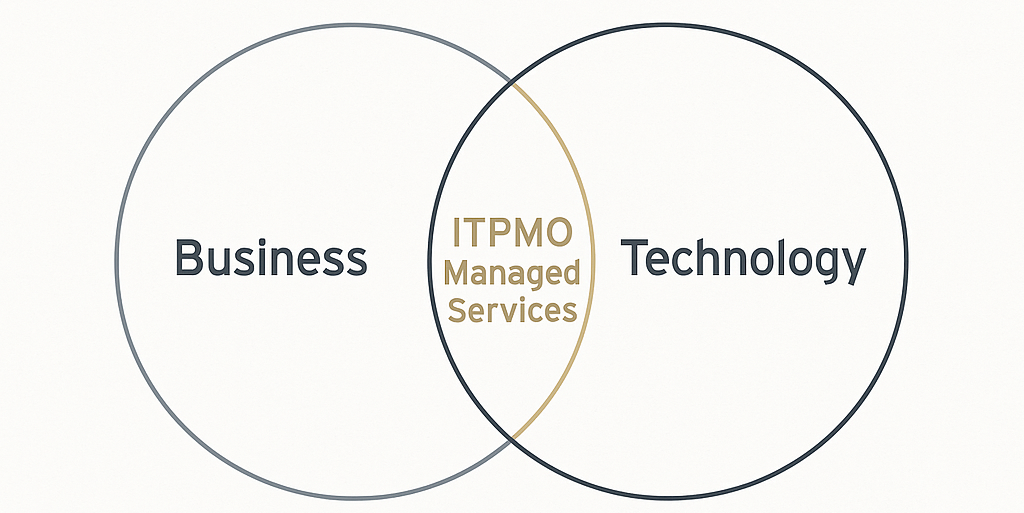In the post I published last week, I explored why IT projects often fail—due to misaligned requirements, accountability gaps, cost ownership conflicts, and insufficient change management. Those challenges are real. What they point to is that many organizations still treat project management as a tactical function, rather than a strategic capability.
In this post, I’ll build on that by making the case for elevating project delivery through an ITPMO Managed Service model. If your organization is engaged in digital transformation, regulatory mandates, or large-scale ERP/BI programs, this follow-up can help you see how to move from firefighting mode to a long-term delivery engine.
Why Traditional PMOs Aren’t Enough
Traditional PMOs tend to focus on control, compliance, and reporting. They enforce consistency, monitor deviations, and manage process adherence. But the pace, complexity, and cross-domain nature of today’s transformations require PMOs to be enablers, not just enforcers.
Think of that last sentence for a moment—how many times have you heard a C-level executive say that about PMOs?
What’s often missing is:
- Dynamic alignment with evolving business strategy
- Flexible resourcing to absorb ups and downs
- Proactive risk forecasting
- Continuous feedback loops and improvement
- Deep integration of change and adoption work
These gaps are exactly where a managed ITPMO can add strategic value.
What Is an ITPMO Managed Service?
At its core, an ITPMO Managed Service is the outsourcing of the functions and capabilities of an IT Project Management Office (PMO) to a specialized provider. This includes:
- Portfolio and program governance
- Standardization of processes, tools, and templates
- Resource capacity planning and allocation
- Risk, issue, and change management oversight
- Benefits realization, tracking, and reporting
- Performance dashboards and metrics for leadership
- Integration of change management, stakeholder engagement, and adoption
- Transition support into operations and continuous improvement
Unlike ad hoc or project-specific PMOs, a managed service “wraps” the ITPMO as an ongoing capability—with scalability, SLAs, and maturity evolution baked in.
In some literature this is referred to as PMO as a Service (PMaaS), which offers flexible resourcing and governance without the overhead of building a permanent internal unit.
What a Managed ITPMO Delivers
Below are four value dimensions that a well-structured ITPMO Managed Service can deliver:
1. Cost Efficiency, Predictability & Resource Leverage
- A managed services model allows pooling of scale, reducing duplication and underutilization. For example, sa.global states that engaging managed services helps reduce IT cost by 25–45 % while increasing operational efficiency by 45–65 % through repeatable learning, best practices, and standardization.
- In the domain of cloud and infrastructure, the Total Economic Impact study of AWS Managed Services showed that organizations avoided costs of hiring extra engineers, reduced management overhead, and improved uptime—leading to strong ROI.
I understand the statistics above are primarily related to IT Managed Services, the same logic applies to ITPMO Managed Services. The savings are there, waiting to be discovered..
2. Acceleration of Delivery & Time to Value
- In the “Inside the PMOaaS Trend” report, ~15 % of organizations already outsource PMO functions. Among them, high-performing PMOs are far more likely to use a PMO-as-a-Service model compared to lower performers (35 % vs 5 %).
- Studies of PMO and project maturity also note that organizations with properly implemented PMO functions have higher delivery success rates, better alignment, and fewer overruns. For instance, PM Solutions reports that mature PMOs yield 64 % better strategic alignment, 62 % more successful projects, and 60 % improved on-time or on-budget delivery.
When you reduce ramp delays, unify processes, reuse templates, and tighten feedback cycles, you effectively compress the delivery curve. I can personally attest to this: on one engagement a few years ago, we reduced the implementation cycle—from ideation to execution—by nearly 60 %.
3. Visibility, Governance & Predictability
- In research around PMOs, their value is often tied to enabling predictability, transparency, and control. A PMO’s ability to provide consistent reporting, historical data, and decision metrics contributes to improved organizational performance.
A managed ITPMO can elevate this by implementing dashboards, dynamic re-prioritization, and risk forecasting continuously, not just at project gates.
4. Access to Broader Expertise & Innovation Leverage
- In the academic work Strategic Innovation Through Outsourcing, the authors point out that outsourcing (or managed services) is shifting away from pure cost focus toward delivering strategic innovation, capability gaps, and value co-creation.
- The concept of “transformational outsourcing” (versus purely operational outsourcing) is also explored in recent studies as a route for organizations to not just get tasks done, but to embed innovation and flexibility at the core of operations.
Through such a model, your ITPMO provider brings a broad lens—cross-sector learnings, access to new tools, and continuous improvement practices that internal teams might never replicate easily.
Key Differentiators vs In-House PMOs:
| Dimension | Managed ITPMO Advantage |
| Capacity | Scale up/down with demand — no long-term fixed headcount |
| Maturity | You get methods, tools, and best practices from day one |
| Capital neutrality | You avoid internal investment in tool licenses, infrastructure, training |
| Objectivity | An external/neutral arbiter helps reduce internal bias in prioritization |
| Continuous Improvement | The service can evolve through maturity cycles rather than static setup |
Closing Thoughts
If your organization is managing multiple transformation initiatives or struggling with delivery consistency, I invite you to reach out.
Whether you’re beginning to formalize an ITPMO or evaluating a move toward a managed ITPMO model, I’d be happy to discuss how we can tailor a solution to your context. Let’s connect and explore how your next phase of delivery maturity can become a strategic differentiator.

